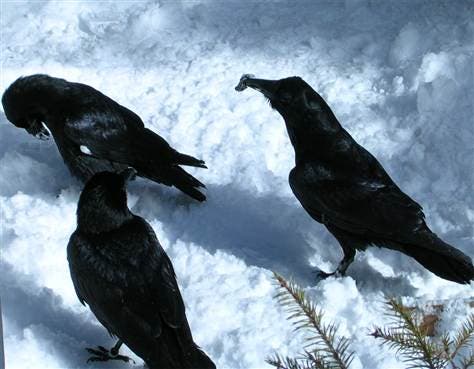We’re inclined to think that gestures are reserved to species which at least possess some kind of articulated limbs. However, scientists have shown that wild ravens purposefully gesture, making it the first time this type of behavior has been observed in the wild except in the closest relatives of humans, primates.

A male raven showing off an object in his beak to his peers. “Hey raven-lady, look at my thing! Here’s some stuff, wanna touch it?” (c) Thomas Bugnyar
Sure, you might argue that you’ve seen your dog maybe come out at you and move or touch you with its snot to show you a certain direction, most likely where you keep your food. Researchers claim, however, that these aren’t naturally developed gestures, instead, they’ve been infused by training.
In the new study, Simone Pika of the Max Planck Institute for Ornithology in Munich, Germany, and Thomas Bugnyar of the University of Vienna observed wild ravens in the Cumberland Wild Park in Grünau, Austria. What they observed amazed them greatly.
RELATED: Urban birds have bigger brains
The ravens would use their beaks in the manner a human uses its hands to show and offer objects such as moss, stones, and twigs. Like all super-efforts on Earth, these gestures were directed towards the opposite sex. As if gesturing wasn’t enough, the ravens would sometime interact with each other using the object, as the researchers could observe the ravens touching or clasping their bills together, or by manipulating the item together.
“Most exciting is how a species, which does not represent the prototype of a ‘gesturer’ because it has wings instead of hands, a strong beak and can fly, makes use of very sophisticated nonvocal signals,” Pika told LiveScience.
Ravens, and their close relatives, crows, and magpies, have been found to be of extreme intelligence for a bird, some actually rivaling great apes in tests, and raven mating pairs show relatively complex communication and high cooperation. The latter part is of severe importance since a further study of the raven, correlated with other data, might help decipher the origin of gesture in human beings.
“Gesture studies have too long focused on communicative skills of primates only. The mystery of the origins of human language, however, can only be solved if we look at the bigger picture and also consider the complexity of the communication systems of other animal groups,” said Pika.
The researchers’ findings were published in the latest issue of the journal Nature Communications.









